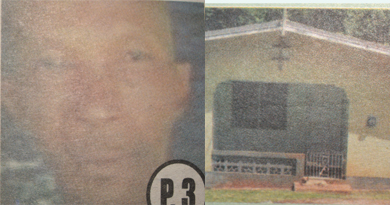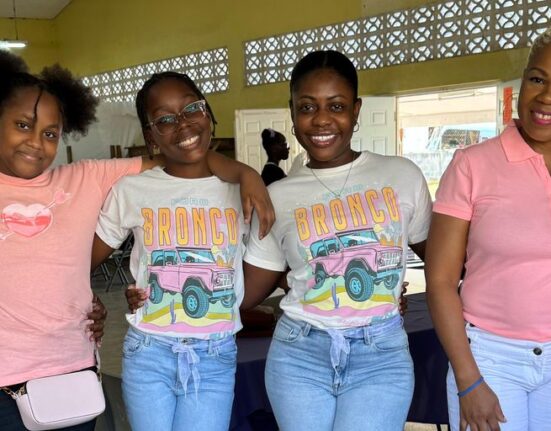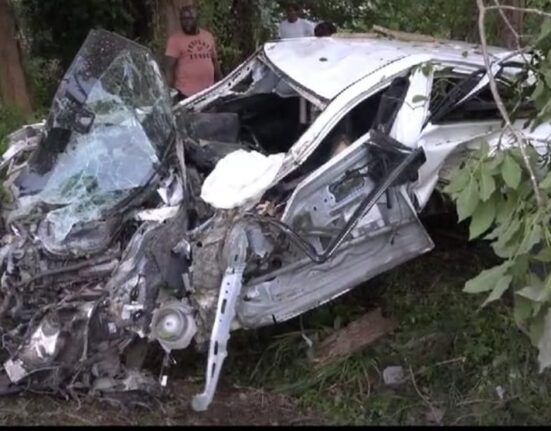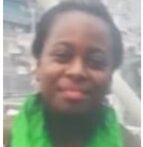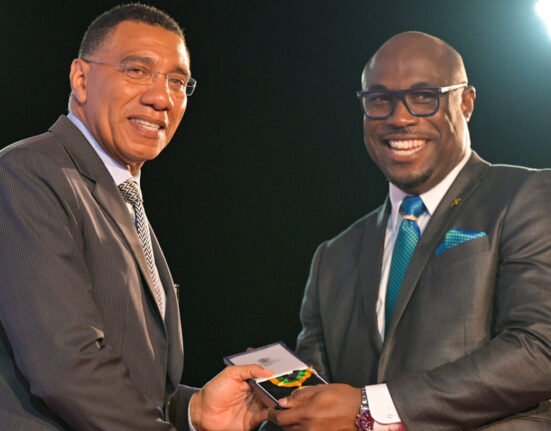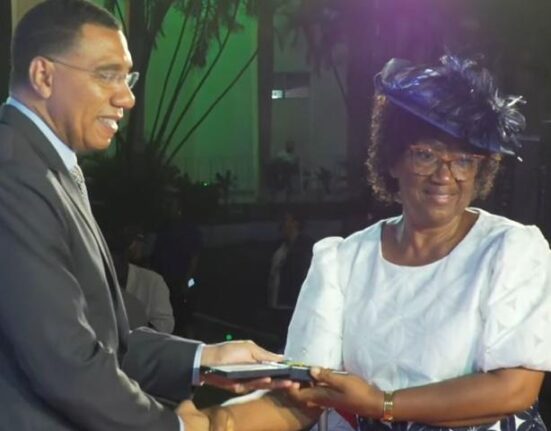For seven days, the seven-member jury consisting of four men and three women, heard of “chopping off of head”, “HIV”, issues of homosexuality, jealousy, headless body, gruesome stabbing, threats and infidelity.
When the trial ended, the jury returned a guilty verdict against Ricketts on Thursday afternoon, November 3.
The prosecution led by assistant director of public prosecutions Maxine Jackson and Crown Counsel Cadeen Barnett, argued that Ricketts was a jealous ex-lover.
The prosecutors also maintained that Thomas’ new lover, Neville Garnett Lewis told Ricketts that he was going to kill Burnett Thomas. However, Ricketts did not tell Thomas of Lewis’ plan. The prosecution further put forward that Ricketts later joined Lewis in carrying out the plan. They also argued that at the time when Ricketts stabbed Thomas with a long machete, Thomas was still alive and not dead.
However, the defense led by attorney Karen Russell argued that it was Neville Garnett Lewis, who had threatened Ricketts to participate in the murder and at the time when Ricketts inflicted around two to three stab wounds to Thomas’ abdomen, his head was already cut off by Lewis and Thomas was dead.
Lewis, who was on the run following Thomas’ murder, was captured by the police in June of 2013 and had already pleaded guilty to the charge of murder. He is serving time. Ricketts, prior to his conviction last Thursday, had always maintained his innocence.
THE PROSECUTION’S EVIDENCE
The murder trial commenced on Wednesday, October 26 and saw the prosecution using the evidence of 13 witnesses to push forward their case.
The most critical evidence for the prosecution, was a question and answer that was held with Howard Ricketts on March 26, 2012 in the presence of his attorney at the time, Susan Hill. That session was carried out between 2 p.m. and 7:10 p.m.
A total of 96 questions were asked, with 96 answers given. Also at the question and answer were the investigating officer, Detective Corporal Maurice Halstead and Detective Constable Orlando Grant, who recorded the questions and answers.
The defense had said during the trial that Ricketts had been “coerced” into saying certain things during the question and answer.
However, the officers both gave evidence that Ricketts was not threatened, no favours were promised to him nor was he coerced into giving any answers at the question and answer session. They also stated that at no time during the interview had Ricketts or his attorney complained about any questions being asked.
Ricketts’ attorney at the time of the question and answer, Susan Hill also testified that no threats of violence was meted out to him (Ricketts) and if he was beaten or coerced into answering the questions, she would have stopped the question and answer. She also said she informed Ricketts of his rights and told him that he did not have to answer any of the questions asked.
Another officer, District Constable Evan Duncan testified that he was not aware of Ricketts sexuality and that he told no prisoner to beat Ricketts.
THE REVELATIONS
The questions and answers were tendered into evidence at the trial and they revealed what happened leading up to the day of the murder, the murder itself and following the murder.
In the question and answer, Howard Ricketts had revealed to the officers that he had an intimate relationship with Burnett Thomas for over ten years and they were lovers.
Ricketts said he met Neville Garnett Lewis through Thomas, but Lewis, who he also called ‘Garnett,’ was not his friend but Thomas’ friend.
When Ricketts was asked about the friendship between Lewis and Thomas, he told the police investigators their friendship was “too close for comfort.” He also told the police that he thought Lewis and Thomas shared an intimate relationship, because Lewis was always calling and texting Garnett (Lewis).
Ricketts also said that Lewis came to the house one night in 2011 and twice in 2012.
On the night of March 24, 2012 at about 7:10 p.m., Ricketts said he received a call from Thomas, asking if Lewis could spend the night at the house. He indicated it was fine. During the question and answer Ricketts had further told the officers that he once shared the same bed with Thomas, but they did not anymore because of Thomas’ unfaithfulness.
Prosecutor Maxine Jackson in her closing arguments to the jurors, explained that Ricketts was a jealous lover and he felt hurt that Thomas was unfaithful. This she said was motive to participate in the crime.
MET AT SUPERMARKET
A relief security guard, Carl Josephs, had testified at the trial that on the night of March 24, 2012, he had come to relieve Burnett Thomas of his duties, but at the time he saw him talking to a young man in his 20’s. Josephs said he overheard when Thomas received a phone call and enquired about “if it was at the new supermarket.” He later told the person on the phone that he would “send him come.”
The young man in his 20’s later left.
In the question and answer given to the police, Ricketts had said that he met with Lewis at a supermarket in Brown’s Town on Saturday night, March 24. They later left and met with Thomas at about 9:30 p.m. at Top Road in Brown’s Town and they all went home to the house in the community of Lincoln.
LEWIS HAD HIV
Later that night at the house, Ricketts was preparing soup, when Lewis told him that Thomas had given him HIV/AIDS. Ricketts himself also had HIV/AIDS and later on that night he went to get his medication and saw Lewis and Thomas in bed and said “yuh nuh easy”, and left.
On the morning of March 25, 2012 at about 4 a.m., Ricketts said that he got up to prepare breakfast to go to work, when Lewis came to him and told him that he (Lewis) was going to kill Thomas, because he had given him HIV.
Ricketts had said that he told Lewis that he should not do that, and Lewis later left and went into the back room of the house where Thomas was.
Ricketts was asked at the question and answer, “Is it true that you didn’t tell Burnett (Thomas) that Garnett (Neville Lewis) was going to kill him?”
Ricketts answered “yes” to that question and further stated that, “I didn’t tell him (Burnett Thomas) that Garnett (Neville Lewis) was going to kill him, because I was emotionally hurt.”
Prosecutor Maxine Jackson told the jurors in her summation that this showed that “Ricketts was hurting so he did not tell Burnett (Thomas), because Burnett had brought another man into the house.” She further argued that this proved that Ricketts had “voluntarily and intentionally planned to kill Thomas with Garnett.”
THE MURDER
There were contradictory reports about the moments leading up to the murder of Thomas by Ricketts.
Ricketts had said that Lewis returned from the backroom with a bloody machete and again told him that he (Lewis) was going to kill Thomas and he went with him to the back room.
Another account said that in the back room, Lewis and Thomas were arguing about the HIV. The two then came out in the living room. Ricketts had further said in the question and answer that Lewis had a short machete and used it to chop Thomas in the neck. Ricketts then assisted Lewis to carry Thomas, who was moaning, to the bedroom at the back of the house.
Ricketts said that Lewis then chopped off Thomas’ head and told him (Ricketts) that he must participate in the act. However, he refused and Lewis threatened him that if he did not participate, then he would be next.
Ricketts said that he pulled a long machete from under the bed and stabbed Thomas (who Ricketts claimed was already dead) about two or three times, to the chest and to the abdomen. He said that blood was splashing.
Ricketts said he later wiped off the cutlass and placed it under the bed. He said that Lewis was the one, who placed Thomas’ head and his (Lewis’) short machete in a rice bag and said he would dispose of it.
Ricketts said he had a shower to wash off the blood and hastily dressed and went to work.
Prosecutor Maxine Jackson argued in her summation that Ricketts did not tell anyone of what happened and even when he gave a statement to the police, prior to being a suspect, he told no one of the threat Lewis had made to him to participate in the act of stabbing Thomas.
However, defense attorney Karen Russell argued that her client, Ricketts was traumatized by the incident. She further said that different persons react differently to certain things.
DOCTOR’S TESTIMONY
Ricketts’ attorney in her summation to the jurors, had contended that the prosecution had only relied on direct evidence from the accused given in the question and answer to outline what happened that night. She said that they presented no eye witness evidence.
She pointed out that her client had answered all questions and this showed his honesty as he was open about his personal life and his HIV status. Russell further argued that her client (Ricketts) had stabbed Thomas when his head was already chopped off and that her client had no intention to kill Thomas, but was threatened.
However, a pathologist with the Ministry of National Security testified that Thomas did not die because of the severing of the head, but because of the stab wounds.
THE CRUCIAL MEDICAL EVIDENCE
The doctor said that he conducted a postmortem examination on the body and severed head of Burnett Thomas, on April 4, 2012 after it was identified by one of Thomas’ brothers, who also testified at the trial.
The mutilated body was about 5 feet 7 inches, partially burnt and slightly bloated. The bloating signified the body was in early stage of decomposition. Thomas’ head was seen separately. The scalp of the head was absent except the face, but the features of the face was poor.
Thomas’ body had skin deep burns which were seen on anterior (front) of the chest, posterior (back) of the chest and legs. There were also muscle deep burns, which were seen to the upper limbs and left thigh.
There were six stab wounds and two incised wounds (cuts). The doctor said that the stab wounds were inflicted by mild to moderate force. Four of the stab wounds were concentrated to the chest and abdomen areas.
Reports showed that death was caused by hemorrhage (bleeding) and shock from the stab wounds. The stab wounds had clean edges which suggest that a sharp cutting tool was used to inflict wounds.
The fatal stab wounds were described by the doctor as stabs number one, two and three, which were seen in the chest and abdomen areas of Thomas’ body. Ricketts in his question and answer had said that he stabbed Thomas about two or three times in his chest and abdomen.
The defense had argued that when Ricketts had inflicted the stab wounds to Thomas, Neville “Garnett” Lewis had already chopped off Thomas’ head.
However, the pathologist said that the head was cut off during perimortem (during the process of death which may take from one to five minutes).The doctor also said at this point one may appear to be dead, but cellular death would have not occurred.
The pathologist was able to indicate that the head was cut off during this period, as there was minimal infiltration of blood in tissues at this area. This led the pathologist to further reveal that the cutting off of the head was not the cause of death of Thomas.
UNSWORN STATEMENT
Following the case by the prosecution, Ricketts’ attorney, Karen Russell made a no case submission. She said the evidence of the prosecution was tenuous or weak. She said that there was no eye witnesses to the case and the prosecution had based their case primarily on a statement made by the police. She said that the accused explained what he witnessed and that he stabbed Thomas when Lewis had chopped off his head.
However, Justice Viviene Harris, the presiding judge, said that Ricketts had a case to answer.
Ricketts later gave an unsworn statement from the dock where he outlined the incident. He said that Lewis told him to help him kill Thomas, because he had HIV.
“Mi say mi nuh know how it a go go, but it a go hard,” Ricketts said he told Lewis.
He said he saw Lewis chop off Thomas’ head, and he stabbed Thomas two to three times.
Following all the evidence and the summations of the prosecution, defense and the judge, the jury later returned a guilty verdict.
